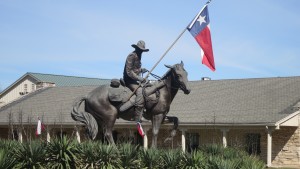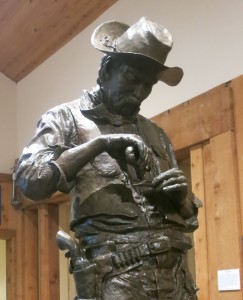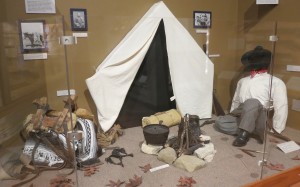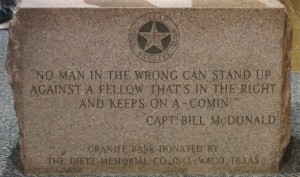Our cross country trip to visit sis in Texas wound down with a stop in Waco, about 200 miles southeast of Wichita Falls. The destination was the Texas Ranger Hall of Fame & Museum, built to celebrate the storied Rangers and home to several thousand artifacts and impressive bronze statues displayed throughout the complex.
Guided tours are the usual way to see the exhibits, and a movie about the history of this colorful organization is a great way to start the visit. We have been to dozens of historical sites over the years and seen many informational presentations, but none quite like this. The Rangers have had moments that were less than stellar during their nearly 200 year existence, and while the movie generously praises the many successes of the group, it does not flinch from relating the scandals that tarnished their reputation during part of the last century. Happily, varying the organizational style and recruitment techniques since then has worked to make the Texas Rangers a strong law enforcement entity, respected around the world.
A bit of history:
With the blessing of the Mexican government, a colony of about 300 families was created at the Northern edge of Mexico in the early 1800s, with the reputed Mexican goal that it would have a bigger claim to the contested land. This outpost was also supposed to act as a buffer between Comanche territory and Hispanic holdings. However, attacks on the settlement became so violent and frequent that in 1823, Steve Austin (with permission from Mexico) hired a group of men to keep the families safe and protect the frontier from Indians, bandits and other marauders. With that mandate, the Texas Rangers were born. They are the oldest state law enforcement agency in the USA.
In the beginning, the Rangers were mostly farmers, not cowboys, and had to provide their own horses and guns. The newly formed band was battling against the best light cavalry in the world, the Comanche Indians, and had to learn how to fight on horseback, rather than as foot soldiers in the tradition of English linear formations of battle they were used to. I’m more of a stand-and-shoot kinda guy, and have only ridden a horse while it walked very slowly, so the idea of having any kind of accuracy with a rifle while on a galloping animal? Boggles the mind.
The Comanches and other native tribes were determined to keep the settlers from gaining a bigger foothold and fiercely defended their territory. While some Native Americans today dispute the way ownership of the land was handled back then, that area was a political geographical hotbed at the time, with several governments claiming rights to the territory.
When fighting became too intense and/or widespread for the original few dozen men to handle, others volunteered to help or were hired temporarily, and it was possible to serve as a Texas Ranger in the Frontier Battalion for as little as six months at a time. There were spies, scouts, mounted riflemen – as varied as the needs of the campaign at hand. The men were promised $1.25 a day, to be paid when Austin raised enough money. That early bunch was the stuff of novels and movies – larger than life characters, living on the open range as they assisted the army, making decisions on their own, saving lives and keeping the peace, whenever they were called upon to do so.
Texas became a Republic in 1836, then a State in America in 1845, and the role of the Rangers changed as the political climate and the growing population required.
We were surprised to hear how few Texas Rangers there have been. In times of heavy conflict, the ranks swelled to 450, but after funding cuts and being split into four companies statewide in 1901, there were only 80 men in total. A few years ago, the numbers rose to 100, and even now in 2015, there are still only 150 commissioned Rangers for the entire State of Texas. That’s less than one Ranger for each of the 254 counties in the State.
Having said that, there’s a definite air of confidence surrounding each of the Rangers we met. You never doubt that they have the experience, the training and the skills to handle any situation that arises. One of the legends that feeds the mystique is a statement attributed to Capt. Bill McDonald. McDonald was sent to Dallas to prevent a prize-fight from being held. A rowdy crowd was getting out of hand, and when he arrived alone, he told the alarmed mayor, “Ain’t I enough? There’s only one prize-fight!”
In 1935, the Texas Rangers came under the jurisdiction of the Department of Public Safety and the Senior Ranger reports directly to the Director of the DPS. These days, the 150 commissioned, active-duty Rangers are divided into companies spread across the State. They are located in Houston, Garland, Lubbock, Waco, McAllen, San Antonio, and ElPaso, with the central headquarters in Austin, the state capitol.
Click on the links for additional information:
http://www.txdps.state.tx.us/TexasRangers/
Next time: “What does a Texas Ranger do?”
*Photos by Patti Phillips, taken in Waco, Texas





There is also a lot of historical information about the original Rangers in a wonderful book called “Empire of the Summer Moon”. I think you would enjoy reading it.
Great! Thanks for the recommendation, Steve. 🙂
are the Texas Rangers higher in rank of all other law enforcement?
No, as a matter of fact, they have to be invited before they can work on the local cases. They are highly trained and specialists in their various fields, but work in Texas only, unless an investigation takes them across State lines.